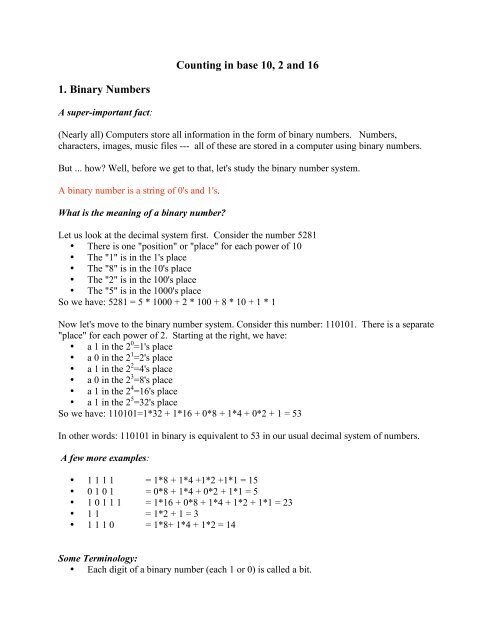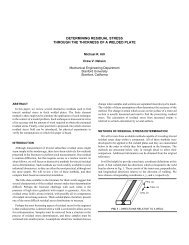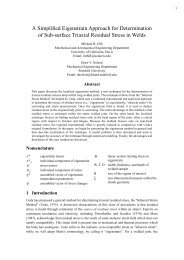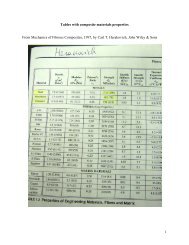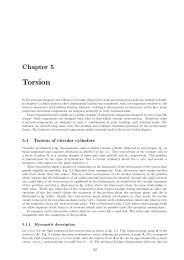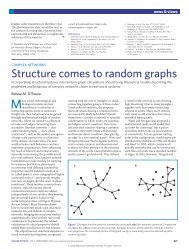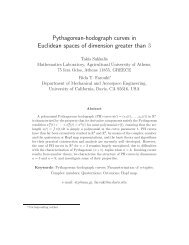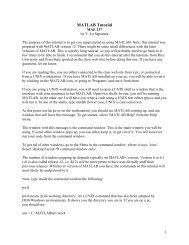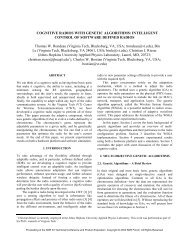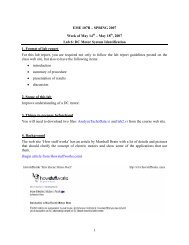Counting in base 10, 2 and 16 1. Binary Numbers
Counting in base 10, 2 and 16 1. Binary Numbers
Counting in base 10, 2 and 16 1. Binary Numbers
Create successful ePaper yourself
Turn your PDF publications into a flip-book with our unique Google optimized e-Paper software.
<strong>1.</strong> B<strong>in</strong>ary <strong>Numbers</strong><br />
A super-important fact:<br />
<strong>Count<strong>in</strong>g</strong> <strong>in</strong> <strong>base</strong> <strong>10</strong>, 2 <strong>and</strong> <strong>16</strong><br />
(Nearly all) Computers store all <strong>in</strong>formation <strong>in</strong> the form of b<strong>in</strong>ary numbers. <strong>Numbers</strong>,<br />
characters, images, music files --- all of these are stored <strong>in</strong> a computer us<strong>in</strong>g b<strong>in</strong>ary numbers.<br />
But ... how? Well, before we get to that, let's study the b<strong>in</strong>ary number system.<br />
A b<strong>in</strong>ary number is a str<strong>in</strong>g of 0's <strong>and</strong> 1's.<br />
What is the mean<strong>in</strong>g of a b<strong>in</strong>ary number?<br />
Let us look at the decimal system first. Consider the number 5281<br />
• There is one "position" or "place" for each power of <strong>10</strong><br />
• The "1" is <strong>in</strong> the 1's place<br />
• The "8" is <strong>in</strong> the <strong>10</strong>'s place<br />
• The "2" is <strong>in</strong> the <strong>10</strong>0's place<br />
• The "5" is <strong>in</strong> the <strong>10</strong>00's place<br />
So we have: 5281 = 5 * <strong>10</strong>00 + 2 * <strong>10</strong>0 + 8 * <strong>10</strong> + 1 * 1<br />
Now let's move to the b<strong>in</strong>ary number system. Consider this number: 1<strong>10</strong><strong>10</strong><strong>1.</strong> There is a separate<br />
"place" for each power of 2. Start<strong>in</strong>g at the right, we have:<br />
• a 1 <strong>in</strong> the 2 0 =1's place<br />
• a 0 <strong>in</strong> the 2 1 =2's place<br />
• a 1 <strong>in</strong> the 2 2 =4's place<br />
• a 0 <strong>in</strong> the 2 3 =8's place<br />
• a 1 <strong>in</strong> the 2 4 =<strong>16</strong>'s place<br />
• a 1 <strong>in</strong> the 2 5 =32's place<br />
So we have: 1<strong>10</strong><strong>10</strong>1=1*32 + 1*<strong>16</strong> + 0*8 + 1*4 + 0*2 + 1 = 53<br />
In other words: 1<strong>10</strong><strong>10</strong>1 <strong>in</strong> b<strong>in</strong>ary is equivalent to 53 <strong>in</strong> our usual decimal system of numbers.<br />
A few more examples:<br />
• 1 1 1 1 = 1*8 + 1*4 +1*2 +1*1 = 15<br />
• 0 1 0 1 = 0*8 + 1*4 + 0*2 + 1*1 = 5<br />
• 1 0 1 1 1 = 1*<strong>16</strong> + 0*8 + 1*4 + 1*2 + 1*1 = 23<br />
• 1 1 = 1*2 + 1 = 3<br />
• 1 1 1 0 = 1*8+ 1*4 + 1*2 = 14<br />
Some Term<strong>in</strong>ology:<br />
• Each digit of a b<strong>in</strong>ary number (each 1 or 0) is called a bit.
• 1 byte = 8 bits.<br />
• 1 KB = 1 kilobyte = 2^<strong>10</strong> bytes = <strong>10</strong>24 bytes (approx 1 thous<strong>and</strong> bytes).<br />
• 1 MB = 1 Megabtye = 2^20 bytes = 1,048,580 bytes (approx 1 million bytes).<br />
• 1 GB = 1 Gigabyte = 2^30 bytes = 1,073,741,824 bytes (approx 1 billion bytes)<br />
Convert<strong>in</strong>g decimal to b<strong>in</strong>ary:<br />
To convert a decimal number to b<strong>in</strong>ary, keep divid<strong>in</strong>g the number by 2 until you get down to 0.<br />
Keep track of the rema<strong>in</strong>ders.<br />
Example: Consider the decimal number 57.<br />
• 57 divided by 2 = 28 Rema<strong>in</strong>der 1<br />
• 28 divided by 2 = 14 Rema<strong>in</strong>der 0<br />
• 14 divided by 2 = 7 Rema<strong>in</strong>der 0<br />
• 7 divided by 2 = 3 Rema<strong>in</strong>der 1<br />
• 3 divided by 2 = 1 Rema<strong>in</strong>der 1<br />
• 1 divided by 2 = 0 Rema<strong>in</strong>der 1<br />
Now list the rema<strong>in</strong>der values from bottom to top: 11<strong>10</strong>01: this is the b<strong>in</strong>ary form of 57.<br />
Let us check our answer (11<strong>10</strong>01) by convert<strong>in</strong>g it back to decimal:<br />
11<strong>10</strong>01 = 32 + <strong>16</strong> + 8 + 1 = 57, so we are correct.<br />
Maximum Value of a b<strong>in</strong>ary number:<br />
Consider a b<strong>in</strong>ary number with N bits (where N is a number).<br />
Its maximum possible value is 2 N – 1 (2 to the power of N, m<strong>in</strong>us 1)<br />
Example:<br />
let N = 3, for a 3-bit b<strong>in</strong>ary number, the maximum value is 111, i.e. 2 3 -1=7<br />
2. <strong>Count<strong>in</strong>g</strong> Us<strong>in</strong>g B<strong>in</strong>ary <strong>Numbers</strong><br />
Consider how count<strong>in</strong>g works <strong>in</strong> the decimal system. We start with 1 digit. We count us<strong>in</strong>g the<br />
numerals 0 through 9. After we reach 9, we've run out of numerals. So, we have to add a second<br />
digit. We start that digit at <strong>1.</strong> Then we cycle the first digit through the numerals 0 through 9<br />
aga<strong>in</strong>, to create the numbers <strong>10</strong>-19. After we reach 19, we've run out of numerals <strong>in</strong> the "1's<br />
place" aga<strong>in</strong>, so we <strong>in</strong>crement the second digit to 2. Eventually, we reach 99. We've run out of<br />
numerals <strong>in</strong> the "1's" place, so we want to <strong>in</strong>crement the second digit aga<strong>in</strong>. But, now we've run<br />
out of numerals for the second digit as well. So, we have to <strong>in</strong>troduce a 3rd digit, <strong>and</strong> we start it<br />
at <strong>1.</strong> And so on.<br />
<strong>Count<strong>in</strong>g</strong> us<strong>in</strong>g b<strong>in</strong>ary numbers works the same way, except that we only have 2 numerals (1 <strong>and</strong><br />
0) for each digit. So, we start with 1 digit. We count us<strong>in</strong>g the numerals 0 through 1:
0<br />
1<br />
We are already out of numerals. So, we have to add a second digit. We start that digit at 1, <strong>and</strong><br />
then we can cycle the first digit through the numerals 0 through 1 aga<strong>in</strong>:<br />
<strong>10</strong><br />
11<br />
Next we add a 3rd digit, <strong>and</strong> start it at <strong>1.</strong> Now we can cycle the 1st <strong>and</strong> 2nd digits as we did<br />
before:<br />
<strong>10</strong>0<br />
<strong>10</strong>1<br />
1<strong>10</strong><br />
111<br />
And so on. Start<strong>in</strong>g from the beg<strong>in</strong>n<strong>in</strong>g aga<strong>in</strong>, the sequence of b<strong>in</strong>ary numbers looks like this:<br />
0<br />
1<br />
<strong>10</strong><br />
11<br />
<strong>10</strong>0<br />
<strong>10</strong>1<br />
1<strong>10</strong><br />
111<br />
<strong>10</strong>00<br />
<strong>10</strong>01<br />
<strong>10</strong><strong>10</strong><br />
<strong>10</strong>11<br />
1<strong>10</strong>0<br />
1<strong>10</strong>1<br />
1111<br />
<strong>10</strong>000<br />
...<br />
Let us rewrite this sequence, with the decimal value of each number listed to the right:<br />
b<strong>in</strong>ary decimal<br />
------ -------<br />
0 0<br />
1 1<br />
<strong>10</strong> 2<br />
11 3<br />
<strong>10</strong>0 4<br />
<strong>10</strong>1 5<br />
1<strong>10</strong> 6<br />
111 7<br />
<strong>10</strong>00 8<br />
<strong>10</strong>01 9<br />
<strong>10</strong><strong>10</strong> <strong>10</strong>
<strong>10</strong>11 11<br />
1<strong>10</strong>0 12<br />
1<strong>10</strong>1 13<br />
11<strong>10</strong> 14<br />
1111 15<br />
<strong>10</strong>000 <strong>16</strong><br />
...<br />
Here is a quick quiz. Consider this large b<strong>in</strong>ary number: <strong>10</strong><strong>10</strong><strong>10</strong>11<strong>1.</strong> What is the next number?<br />
Answer: <strong>10</strong><strong>10</strong>1<strong>10</strong>00<br />
3. Hexadecimal<br />
We've looked at the decimal number system (<strong>base</strong> <strong>10</strong>) <strong>and</strong> the b<strong>in</strong>ary number system (<strong>base</strong> 2).<br />
The hexadecimal system has a <strong>base</strong> of <strong>16</strong>, but it works the same way.<br />
One tricky po<strong>in</strong>t regard<strong>in</strong>g the hexadecimal system is that it uses <strong>16</strong> different numerals: the<br />
regular numerals 0 through 9, <strong>and</strong> then the capital letters A through F.<br />
hexadecimal decimal equivalent<br />
----------- ------------------<br />
0 0<br />
1 1<br />
2 2<br />
3 3<br />
4 4<br />
5 5<br />
6 6<br />
7 7<br />
8 8<br />
9 9<br />
A <strong>10</strong><br />
B 11<br />
C 12<br />
D 13<br />
E 14<br />
F 15<br />
Convert<strong>in</strong>g Hexadecimal to Decimal<br />
Consider this hexadecimal number: AC7. There is a separate position for each power of <strong>16</strong>.<br />
Start<strong>in</strong>g at the right, we have:<br />
o a 7 <strong>in</strong> the 1's place<br />
o a C <strong>in</strong> the <strong>16</strong>'s place<br />
o an A <strong>in</strong> the <strong>16</strong> 2 =256's place<br />
So we have:
AC7 = A*256 + C*<strong>16</strong> + 7*1 = <strong>10</strong>*256 + 12*<strong>16</strong> + 7 = 2759<br />
In other words: AC7 <strong>in</strong> hexadecimal is equivalent to 2759 <strong>in</strong> our usual decimal system of<br />
numbers.<br />
Convert<strong>in</strong>g B<strong>in</strong>ary to Hexadecimal (Hex)<br />
Consider the follow<strong>in</strong>g table, which shows the hexadecimal equivalent of the 1st <strong>16</strong> b<strong>in</strong>ary<br />
numbers.<br />
Decimal B<strong>in</strong>ary Hexadecimal<br />
0 0000 0<br />
1 0001 1<br />
2 00<strong>10</strong> 2<br />
3 0011 3<br />
4 0<strong>10</strong>0 4<br />
5 0<strong>10</strong>1 5<br />
6 01<strong>10</strong> 6<br />
7 0111 7<br />
8 <strong>10</strong>00 8<br />
9 <strong>10</strong>01 9<br />
<strong>10</strong> <strong>10</strong><strong>10</strong> A<br />
11 <strong>10</strong>11 B<br />
12 1<strong>10</strong>0 C<br />
13 1<strong>10</strong>1 D<br />
14 11<strong>10</strong> E<br />
15 1111 F<br />
Given this chart, it is easy to transform b<strong>in</strong>ary numbers <strong>in</strong>to decimal form. Let us take an 8-bit<br />
example: <strong>10</strong>001<strong>10</strong>0<br />
To convert to hex, we divide the number <strong>in</strong>to groups of 4 bits (start<strong>in</strong>g at the right-h<strong>and</strong> side):<br />
<strong>10</strong>00 1<strong>10</strong>0<br />
Then, we convert each group of 4 bits to the hexadecimal equivalent, us<strong>in</strong>g the chart above:<br />
8 C<br />
And that is all there is to it! Thus, the b<strong>in</strong>ary number <strong>10</strong>001<strong>10</strong>0 is equal to 8C <strong>in</strong> hex.<br />
This easy conversion from b<strong>in</strong>ary to hexadecimal makes hexadecimal notation very convenient.<br />
Instead of writ<strong>in</strong>g out a very long b<strong>in</strong>ary number, we can represent it compactly us<strong>in</strong>g<br />
hexadecimal.
Example #2:<br />
Start with this b<strong>in</strong>ary number: <strong>10</strong>0<strong>10</strong><strong>10</strong>001<strong>10</strong><strong>10</strong>1<br />
Divide the number <strong>in</strong>to groups of 4 bits:<br />
<strong>10</strong>0 <strong>10</strong><strong>10</strong> 0011 0<strong>10</strong>1<br />
Now add a 0 to the front of the 3-digit group on the left:<br />
0<strong>10</strong>0 <strong>10</strong><strong>10</strong> 0011 0<strong>10</strong>1<br />
Now convert each 4-digit b<strong>in</strong>ary number to a hex number:<br />
4 A 3 5<br />
And this is our f<strong>in</strong>al answer: 4A35<br />
Convert<strong>in</strong>g Hex to B<strong>in</strong>ary<br />
Convert<strong>in</strong>g a hexadecimal number to b<strong>in</strong>ary is just as easy: just convert each hexadecimal digit<br />
to a 4-digit b<strong>in</strong>ary number, accord<strong>in</strong>g to the same table!<br />
Example:<br />
D7A = D 7 A = 1<strong>10</strong>1 0111 <strong>10</strong><strong>10</strong> = 1<strong>10</strong><strong>10</strong>111<strong>10</strong><strong>10</strong><br />
<strong>Count<strong>in</strong>g</strong> <strong>in</strong> Hexadecimal<br />
<strong>Count<strong>in</strong>g</strong> <strong>in</strong> hexadecimal is just like count<strong>in</strong>g <strong>in</strong> the decimal system, except that we cycle each<br />
digit through the numerals 0 to F (<strong>in</strong>stead of 0 to 9).<br />
Thus, count<strong>in</strong>g <strong>in</strong> hexadecimal goes like this:<br />
hexadecimal decimal equivalent<br />
----------- ------------------<br />
0 0<br />
1 1<br />
2 2<br />
3 3<br />
4 4<br />
5 5<br />
6 6<br />
7 7<br />
8 8<br />
9 9
A <strong>10</strong><br />
B 11<br />
C 12<br />
D 13<br />
E 14<br />
F 15<br />
<strong>10</strong> <strong>16</strong><br />
11 17<br />
12 18<br />
...etc.<br />
1F 31<br />
20 32<br />
21 33<br />
...etc.<br />
2F 47<br />
30 48<br />
31 49<br />
...etc.<br />
FF 255<br />
<strong>10</strong>0 256<br />
4. The ASCII Code (American St<strong>and</strong>ard Code for Information Interchange)<br />
Computers store all <strong>in</strong>formation as numbers (b<strong>in</strong>ary numbers). So, how do we represent a<br />
keyboard character as a number? The answer is: we use the ASCII Code! This is <strong>in</strong> fact a very<br />
simple idea:<br />
The ASCII Code assigns a number (between 0 <strong>and</strong> 127 <strong>in</strong>clusive) to each keyboard character.<br />
Each ASCII code number is represented by a 7-bit b<strong>in</strong>ary number. However, 8 bits are used for<br />
each number, for convenience.<br />
Examples: (The numbers shown are decimal numbers.)<br />
• A to Z: 65 - 90<br />
• 0 to 9: 48 - 57<br />
• $ - 36<br />
Application:<br />
D e a r<br />
ASCII code 68 <strong>10</strong>1 97 114<br />
Hexadecimal 44 65 61 72<br />
B<strong>in</strong>ary 0<strong>10</strong>00<strong>10</strong>0 01<strong>10</strong>0<strong>10</strong>1 01<strong>10</strong>0001 011<strong>10</strong>0<strong>10</strong>
5. Unicode<br />
The ASCI code is <strong>in</strong>sufficient: 127 characters is not enough particularly for other languages than<br />
English. Unicode was developed to solve this problem. It works under the ame pr<strong>in</strong>ciple as<br />
ASCII code, with 1 unique number per character. However, the code supports many more<br />
characters (at least 65,536)


